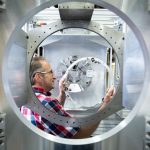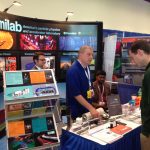Daniel Garisto
Early Tuesday morning, three physicists—James Peebles, Michel Mayor and Didier Queloz—were rewarded for decades seminal contributions to advancing science with a phone call from Stockholm. This year’s Nobel Prize in Physics was awarded “for contributions to our understanding of the evolution of the universe and Earth’s place in the cosmos.”
In recent years, scientists have found ways to study black holes, listening to the gravitational waves they unleash when they collide and even creating an image of one by combining information from radio telescopes around the world. But our knowledge of black holes remains limited. So scientists are figuring out how to make do with substitutes — analogs to black holes that may hold answers to mysteries about gravity and quantum mechanics.
What if you could accelerate particles to higher energies in only a few meters? This is the alluring potential of an up-and-coming technology called plasma wakefield acceleration. Scientists around the world are testing ways to further boost the power of particle accelerators while drastically shrinking their size.










